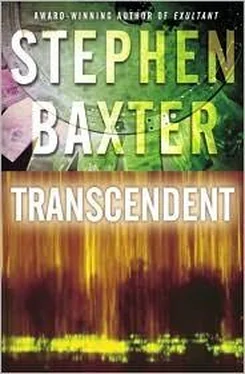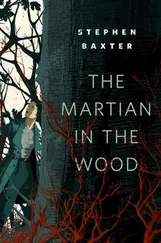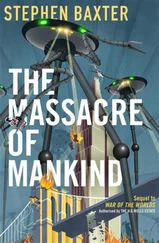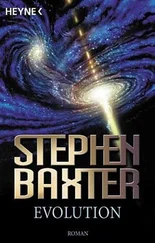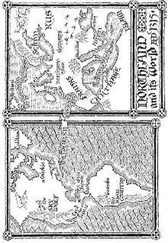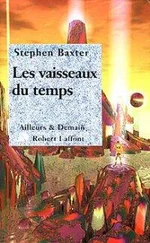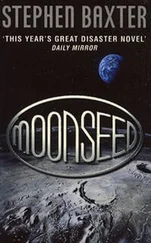I spoke to Rosa again. She told me, “There has been an upsurge in sightings — hauntings, poltergeist phenomena, you name it — all over the planet.”
“Really? I had no idea.”
She snorted. “Why would you? You would not look in the places where you might discover such things. Nor would I, in normal times. But, prompted by your experiences, I have been researching. You aren’t alone, Michael, for better or worse. The whole world is suddenly haunted! And this has happened before. History shows it; there have been previous plagues of ghosts. Now, what do you suppose this means?”
I had no idea. I didn’t know whether to be reassured or terrified.
I felt guilty about working on this stuff in the middle of the hydrate project. I kept it a secret from Tom, Shelley, and the others. It was like I was looking at porn. But I did it. I summoned Rosa, like raising a VR ghost, to my Palm Springs hotel room.
In the flimsy gaudiness of the room, with its late-twentieth-century American tourist chic, Rosa was a dark, sullen mass, small and hunched, her priest’s robes so black they seemed to suck the light out of the air. When she first appeared she seemed disconcerted. She looked around as if finding it hard to focus. Then she saw me, and nodded, unsmiling. “Michael.”
I asked, “Are you OK? You look a little travel-sick.”
Her mouth twitched, a characteristically minimal expression from Aunt Rosa. But her response came a discernible fraction of a second after the cue, enough to remind me that this was not real, that we were not together separated by light speed delays. “I’m fine. But the older I get the harder it is for my system to accommodate multiple realities. As you will learn.” She looked down at her black eroded pillar of a body, spread her liver-spotted hands. “Just think! I do not actually need to look like this. I could have materialized as Marilyn Monroe — have you ever heard of her?”
“Perhaps we should sit down.”
Rosa rested her hands on something — it materialized when she touched it, a light, high-backed chair — and dragged it toward my table. “We may as well look as if we share the same universe,” she said.
I walked to the table and sat stiffly. I described EI’s conference room to her. “It was a hell of a lot better than this. Really, you wouldn’t have known who was really there and who wasn’t, the interfaces were that good. Of course the illusion relies on the human factor, on protocols. You have to make sure you don’t break the rules, do things that are impossible in the consensual reality—”
“Like this?” She reached out of shot and picked up a mug. Like the chair, it appeared out of nowhere, captured by her imaging system as a contiguous part of her extended self. “As a Catholic priest I spend an awful lot of my time on protocols, of one kind or another. I don’t imagine we could run our lives, or manage our souls, without them. I wonder if your apparitions follow their own protocols. Are they systematic, confined by rules?…”
And so we were getting to the point.
Rosa conjured up a VR reconstruction of those strange moments in Spain, as the dust storm had closed in. A miniaturized slab of the Reef coalesced out of the air over my tabletop, and I cleared the water jug and other junk off the table to save confusing the system.
Lumpy and massive, the virtual Reef looked like the papier-mвchй hillsides I used to build as a kid to drive my toy cars over. But the representation was finely detailed. I could see the glittering of crushed automobile hoods and smashed windscreens, and I picked out the crudely hewn stairs that led up to the cave where Rosa and I had eaten. And when I bent down to peer into the mouth of the cave, I saw two little figures sitting at a table. Each the size of my thumbnail, they were charming, like toys in a doll’s house; I had an impulse to pick up the tiny model of me and examine it more closely.
“This is a reconstruction,” Rosa said. “The records are sparse. The Reef is thinly monitored, relatively. This is the best we can do, for now.”
The projection ran forward. The dust storm descended, a crimson cloud descending in silence, like weather on Mars.
Then she appeared — Morag, the visitor, on the slope of the Reef. I saw that toy representation of myself throw back his chair and dart out of his metal-walled cave in pursuit. The little Rosa and the burly landlady dragged him back, and Morag retreated into the dark shadows of the storm. All this was played out in silence. As Morag was on the cusp of vanishing into the dust cloud, Rosa froze the image.
“Can you magnify this thing?” I touched the doll image of Morag; my finger brushed her, scattering tiny pixels.
The image ballooned, but as it enlarged it became increasingly fuzzy. When the face expanded it was no more than a sketch, a default female-human. It could have been anybody. I was crushingly disappointed.
“This is based on the available records, and on what I saw,” Rosa said. “My eyes are good, better than I deserve at such an age. But the figure was simply too far away, the dust swirling and obscuring.”
“You are painfully honest,” I said.
“Extraordinary claims require extraordinary validation.”
“So you can’t be sure it was Morag.”
“I’m sorry.” The magnified image of Morag dissipated. “And I wasn’t able to capture any of her speech — that strange high-speed monologue we heard.”
I rubbed my chin. “So this is all we have. If only the surveillance density had been greater! Bad luck she showed up in a place like this.”
“That might not have been a coincidence at all,” Rosa said. “If she, or whoever is behind the apparition, is determined to remain obscure — to tantalize rather than to reveal — then she would naturally do it this way, in a place where surveillance is sparse, in glimpses through dust clouds, retreating.”
“Why do you call it an apparition? It’s a ghost — isn’t it?”
She sat back in her chair. “Not necessarily. Michael, I’m afraid to deal with this we will have to delve into the pseudo-science of the supernatural…”
Humans stick words on things, like bright yellow labels. It is our way of dealing with the universe. And even phenomena that are not part of our consensual reality have accumulated a vocabulary of their own.
“An apparition is just that, an appearance of something, ” Rosa said. “If you want an even broader label for what is happening here, you can talk of a haunting as an interaction between an agent and a percipient — your Morag-figure is the agent, you see, and you the percipient. The agent could be some external phenomenon, either natural or supernatural, or maybe something emanating from inside your own head: all of these are agents, you see. The language is nonjudgmental. Now, a true ghost is something more specific: a ghost is one class of apparition, a manifestation of somebody deceased.”
“Morag is dead.” Absurd how difficult it was to say that, even after all these years.
“Yes,” Rosa said. “But we don’t know if this is Morag in any sense. And there are other types of apparitions.”
You could also have visions of people who were still alive: there were “wraiths” and “crisis ghosts,” manifestations of living people going through some trauma. You had ghosts of the specialized kind, like poltergeists. You had animal ghosts. And so on.
Hauntings of all kinds had a long history, she said. Arguably you could trace the idea of ghosts all the way back to the tale of Gilgamesh, four thousand years back. The ancient Greeks and Romans told each other ghost stories, and the more rational of them tried to investigate hauntings and other spooky phenomena.
Читать дальше
